Nike is a company that depends heavily on its brand image and corporate reputation. It is considered to be a leader in the apparel/footwear industry. Nike's reputation was valued at $3.9 billion in 1993. However its reputation was subsequently heavily tarnished by accusations that it takes advantage of sweatshop labor in the manufacture of its shoes.
Nike does not manufacture its own products but designs and markets them. They are manufactured by contractors in countries where labor is cheap. During the 1990s it employed around 550,000 workers in 700 factories in 50 countries to make Nike products, the 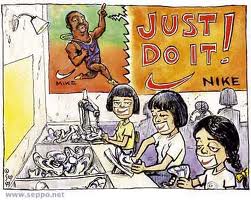 majority in Asia. Nike consistently sought the cheapest labor markets to manufacture and its contractors tend to pay close to the minimum wage. This cheap labor enables Nike to spend a great deal on design and marketing, pay large executive salaries, maintain large profits, and still keep the cost of the shoes affordable to the middle classes in affluent countries. Shoes that cost $16.75 to manufacture were being sold for around $100 in the US.
majority in Asia. Nike consistently sought the cheapest labor markets to manufacture and its contractors tend to pay close to the minimum wage. This cheap labor enables Nike to spend a great deal on design and marketing, pay large executive salaries, maintain large profits, and still keep the cost of the shoes affordable to the middle classes in affluent countries. Shoes that cost $16.75 to manufacture were being sold for around $100 in the US.
Nike spends large money on advertising and promotion — $1.13 billion in 1998. Celebrities, such as Michael Jordan, Andre Agassi, John McEnroe, Monica Seles and Carl Lewis are paid huge sums of money for their endorsement and association with  Nike products. For example, Tiger Woods was paid $28 million and Michael Jordan was paid $45 million in 1998 by Nike. Endorsements from celebrity sports stars “cast a halo over products… Psychologically, we create a mental bond between the product, the famous face, and the company that justifies higher prices.” Endorsed products promise both quality, as attested to by the celebrity, and status.
Nike products. For example, Tiger Woods was paid $28 million and Michael Jordan was paid $45 million in 1998 by Nike. Endorsements from celebrity sports stars “cast a halo over products… Psychologically, we create a mental bond between the product, the famous face, and the company that justifies higher prices.” Endorsed products promise both quality, as attested to by the celebrity, and status.
Since Nike spends so much on marketing and so little on the product itself, it is clear that the reputation of its brand is all-important to Nike. Naomi Klein has noted that “In many ways branding is the Archilles' heel of the corporate world. The more these companies shift to being all about brand meaning and brand image, the more vulnerable they are to attacks on image. So when it’s contractors were accused of manufacturing Nike products in sweatshop conditions, using child labor, paying less than the minimum wage, enforcing overtime, subjecting employees to verbal abuse and sexual harassment and running factories like prison camps, Nike was in trouble.
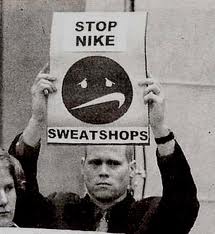 In 1991 UK Thames TV, the Economist and Knight Ridder reported on conditions in Nike factories in Indonesia. US television network CBC reported in 1993 that workers also suffered physical and sexual abuse on top of their low wages and an exhausting quota system. It reported that Nike workers in Vietnam earned an average of 20c per hour and were subject to physical punishments such as being hit on the head by supervisors and being forced to kneel on the ground with their hands in the air for periods of time. The New York Times, International Herald Tribune and Economist also reported on Nike's Asian factories in 1993. Further bad press in 1994 included investigative reports in The Rolling Stone, Boston Globe, Los Angeles Times and Chicago Tribune, and a book by Donald Katz called Just Do It.
In 1991 UK Thames TV, the Economist and Knight Ridder reported on conditions in Nike factories in Indonesia. US television network CBC reported in 1993 that workers also suffered physical and sexual abuse on top of their low wages and an exhausting quota system. It reported that Nike workers in Vietnam earned an average of 20c per hour and were subject to physical punishments such as being hit on the head by supervisors and being forced to kneel on the ground with their hands in the air for periods of time. The New York Times, International Herald Tribune and Economist also reported on Nike's Asian factories in 1993. Further bad press in 1994 included investigative reports in The Rolling Stone, Boston Globe, Los Angeles Times and Chicago Tribune, and a book by Donald Katz called Just Do It.
By 1997 Nike had become a symbol of sweatshop labor in the third world and was the target of many protests, outside store openings and by students against their universities’ links with Nike. In October 1997 anti-Nike rallies were held in 50 US cities and 11 other countries.
In response to the criticism Nike formulated a Code of Conduct for its contractors. The Code first formulated in 1992 and amended in 1997 and 1998 was supposed to apply in all factories producing Nike products. It included minimum wages (as set in the host country), maximum mandatory working hours of 60 per  week, a minimum age for workers of 16 years old, a ban on forced labor and minimum safety and environmental standards.
week, a minimum age for workers of 16 years old, a ban on forced labor and minimum safety and environmental standards.
Nike hired the multinational accounting firm Ernst and Young to conduct audits of its contractors factories and in 1997 Nike paid former United Nations Ambassador Andrew Young to visit its contractors’ factories in Asia and report on working conditions. Human rights groups criticized his tour as a public relations sham.
Nike continued to defend its wage levels with commissioned studies and rhetoric. CEO Phil Knight claimed that working conditions in Asian factories had improved drastically since Nike began business 25 years before and that workers in shoe factories just ten years before who had gone to sleep and woken up today would think they had “died and gone to heaven”. At the 1997 meeting of Business for Social Responsibility a Nike representative showed a video of happy workers in a Vietnamese factory.
A couple of days later, however, the New York Times reported on a leaked audit report by Ernst and Young which had found a Vietnamese factory manufacturing Nike products lacked adequate safety equipment and training, and exposed workers to hazardous chemicals, noise, heat and dust. In parts of the factory carcinogens exceeded Vietnamese standards by 177 times. Seventy seven percent of workers suffered respiratory problems. Also the factory management encouraged up to 700 hours of overtime per year in a country where the legal limit was 200 hours per year. Ernst and Young nevertheless concluded the factory complied with the Nike Code of Conduct.
The leaking of the report and a critique of it by the Transnational Resource and Action (TRAC) “generated a series of scathing articles and columns on the business pages and sports pages of newspapers across the U.S. and around the world.”
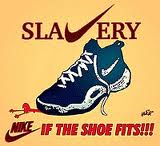 By 1998 the damage to Nike’s reputation was beginning to be felt in the account books. Share prices were dropping and sales were weak. Knight admitted, “The Nike product has become synonymous with slave wages, forced overtime and arbitrary abuse”.
By 1998 the damage to Nike’s reputation was beginning to be felt in the account books. Share prices were dropping and sales were weak. Knight admitted, “The Nike product has become synonymous with slave wages, forced overtime and arbitrary abuse”.
Nevertheless, Nike poured its marketing expertise into its own corporate reputation and sought to portray a caring company that was concerned about working conditions in its contractors’ factories. It hired a former Microsoft executive to be vice president for corporate and social responsibility and expanded its Corporate Responsibility (CR) Division to 70 people.
Nike’s public relations campaign included upgrading its own code of conduct and participating in a range of coalitions including the Global Alliance for Workers and Communities aimed at helping workers in third world shoe and clothing factories and other business coalitions that represented social responsibility, like Business for Social Responsibility.
Nike spent money on philanthropy in countries where its products were made, although not large sums – for example, $100,000 in Indonesia since 1998 for continuing education programs for Nike workers and $150,000 over the next two years for small loans to unemployed/disadvantaged people, and similar schemes in Vietnam. It gave handpicked students and journalists tours of selected factories. However it continued to oppose labor and human rights linkages to trade agreements.
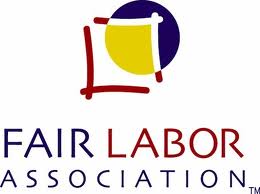 Nike also repeatedly referred to its membership of the Fair Labor Association (FLA) set up in 1998 with the help of White House, together with the US Dept of Labor and the apparel industry, purportedly to safeguard working conditions in factories contracted to US companies. A number of NGOs were involved in its formation although two unions, a department store and the Interfaith Center on Corporate Responsibility pulled out because they disagreed with the final agreement and were concerned that the FLA was little more than a public relations exercise.
Nike also repeatedly referred to its membership of the Fair Labor Association (FLA) set up in 1998 with the help of White House, together with the US Dept of Labor and the apparel industry, purportedly to safeguard working conditions in factories contracted to US companies. A number of NGOs were involved in its formation although two unions, a department store and the Interfaith Center on Corporate Responsibility pulled out because they disagreed with the final agreement and were concerned that the FLA was little more than a public relations exercise.
The FLA has a voluntary code of conduct and member companies that comply will be able to have a “No Sweat” label on their goods. The code says that companies will pay the minimum wage, or prevailing industry wage of the country in which they are operating but makes no provision that companies should pay a wage that workers can live on. Since many poor countries compete for international investment by keeping the minimum wage low, the minimum wage is often below a subsistence income, especially for supporting a family.
The FLA code limits mandatory overtime so workers cannot be made to work more than 60 hours a week. However a compulsory 60-hour week is excessive and there are no limits on voluntary overtime above and beyond this. The very low wages ensure that workers need to work overtime in order to earn enough to live on.
The FLA code gives very limited support for the right of workers to organize in unions. It merely says that corporations will not “affirmatively seek the assistance of state authorities to prevent workers from exercising these rights. According to Alan Howard from the Union of Needletrades, Industrial and Textile Employees (UNITE), this means “you can let the army into the factory to put down a strike, as long as you don’t pick up the phone and call them.”
The code also has provision for ‘independent’ monitoring but the company can choose an accredited monitor such as Ernst and Young, and it can recommend which 10% of their factories will be monitored (5% after three years). Monitoring reports do not have to be made public. Community Aid Abroad estimates that factories will be visited about once every ten years and then they will be given advance notice of a visit.
Medea Benjamin of Global Exchange pointed out:
According to this agreement, companies could still pay their workers 20 cents an hour, coerce them into countless hours of ‘voluntary overtime,’ use accounting firms that have no connection to workers as their external monitors and be rewarded for this behavior with a ‘no sweatshop’ seal of approval.
Nike encouraged many university administrations to join the FLA to give it credibility and well over a hundred did but student activists were concerned about the involvement of companies like Nike and the effectiveness of the monitoring process. In October 1999 they formed their own alliance together with unions and human rights groups: the Workers’ Rights Consortium (WRC).
The Workers Rights Consortium promotes a “living wage” rather than minimum wage, that is, that workers be paid enough to meet their basic needs of food, clothing and shelter and allow a little extra for discretionary spending. Nike's CEO has called the requirement for companies to pay a living wage “unrealistic” but Benjamin estimated in 1998 that if Nike doubled the wages of workers in Nike factories in Indonesia from 10cents/hour to 20 cents it would cost an extra $20 million a year. This is what Nike spends on sponsoring the Brazilian soccer team and is less then 3% of Nike's annual advertising budget.
Nike has ‘partnerships’ with over 200 tertiary US colleges and universities. Increasingly, however, under pressure from student activists, universities have been joining up with the Workers Rights Consortium rather than the FLA. Some 50 universities have joined up so far to the dismay of Nike which has withdrawn from a contract to supply hockey equipment to Brown University and has also withdrawn funding from Michigan University in the wake of their joining the WRC.
When the University of Oregon joined the WRC, Phil Knight, who had personally given the University, which he himself had attended, $50 million over the years, announced he would not be making any further donations “of any kind” to the University. He claimed that “By joining the Worker Rights consortium, the University of Oregon inserted itself into the new global economy where I make my living. And it inserted itself on the wrong side, fumbling a teachable moment.”
 Subsequent surveys continued to find that workers making Nike products suffering inadequate wages, abusive treatment and excessive work hours as well as intimidation if they try to form unions. Huge disparities remain. Chinese workers receive about $1.50 per pair of shoes that sell for $80-$120.
Subsequent surveys continued to find that workers making Nike products suffering inadequate wages, abusive treatment and excessive work hours as well as intimidation if they try to form unions. Huge disparities remain. Chinese workers receive about $1.50 per pair of shoes that sell for $80-$120.
The rewards for those who manufacture the products (average of $786 per year in Indonesia in 2000) are minute compared with those who endorse them. “In one year, Nike paid Jordan as much (about $25 million) to pitch the shoes as its subcontractors paid 35,000 Vietnamese to make them.”
Nike executives are also very well paid. CEO Phil Knight is a billionaire, one of the richest men in the world, and in the year ended 31 May 2000 earned a salary of $1.2 million and a bonus of $1.3 million—up 26% on the previous year.
Community Aid Abroad in Australia points out, “As the company with the largest profit margins Nike could more easily afford to ensure decent pay and conditions in its suppliers’ factories”. Instead Vietnamese workers making Nike products earned less than half of what other foreign companies (apart from Reebok) pay their least skilled factory workers in Vietnam.”
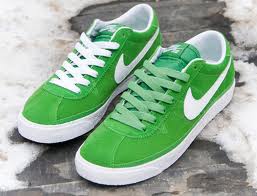 There is some evidence that Nike began concentrating on its environmental reputation after having little success with its human rights reputation. In 1998 Nike joined 20 other major US companies that committed themselves to no longer using or selling wood and paper products made from “old growth” forests. The agreement was negotiated by a coalition of environmental groups including Greenpeace, the Natural Resources Defense Council, and the Rainforest Action Network.
There is some evidence that Nike began concentrating on its environmental reputation after having little success with its human rights reputation. In 1998 Nike joined 20 other major US companies that committed themselves to no longer using or selling wood and paper products made from “old growth” forests. The agreement was negotiated by a coalition of environmental groups including Greenpeace, the Natural Resources Defense Council, and the Rainforest Action Network.
In 1998 Nike promised to phase out the use of polyvinyl chloride (PVC) from its shoes. It enrolled Greenpeace, which has a campaign against PVC worldwide, to publicize the promise. In a press conference in Oregon, Nike's home state, Greenpeace read a Nike company statement which said that the search for a suitable substitute for PVC had “barely just begun”. It was unable to predict when its shoes would be PVC-free. Nike stated that the “action was not intended to divert attention away from criticism it has received over its labor practices in low-wage countries.”
Nike director of corporate responsibility, Sarah Severn, stated at a Greenpeace Business and the Environment conference in Sydney in 2000, that it did not choose to publicize its decision to remove PVC from its shoes because it would have been accused of greenwashing. Apparently Nike believed that if Greenpeace did the PR for them, the greenwashing label would not be used.
Nike also made efforts to recycle excess rubber from factories, converting to water-based solvents and recycling used shoes. It developed a tank top made of 75 percent recycled plastic and the t-shirts it sold in the US contained 3% organic cotton. It promised to be able to make 90% of its shoes without toxic glues, cleaners and solvents by 2001. It is embracing the language of environmental responsibility including the ‘triple bottom line’ and for its efforts it was chosen as one of the companies that are included in the Dow Jones sustainability Index.